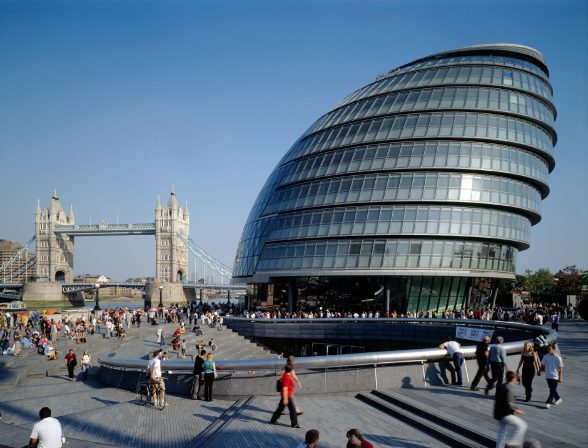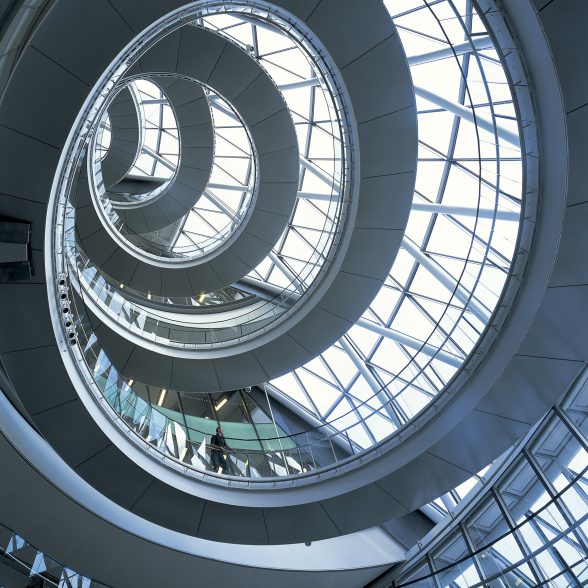This website uses cookies
This website uses cookies to enable it to function properly and to analyse how the website is used. Please click 'Close' to accept and continue using the website.



Image credit: Foster and Partners / Dennis Gilbert
C20 Society has submitted a spot-listing application for the former City Hall (Foster + Partners, 2000-02), in a final effort to save the London landmark from partial demolition.
The Society had previously welcomed efforts to find a new use for the vacant building, and engaged constructively with developers at pre-app discussions. However, as a purpose-built home for the capital’s democracy and a symbolic project of the new millennium, a sympathetic approach to any conversion or alterations was essential. Yet the scheme unveiled by architects Gensler in January 2024, would see every element of architectural significance stripped away. Existing floorplates would be retained and expanded, by removing and infilling the helical stairway, while the geometric glazing would be stripped and external balconies added, reducing the building to a cynical silhouette of its former self.
While our recommendation to list City Hall was initially rejected in 2022, Historic England pointedly did not rule out that the criteria for Grade II listing may be met in the future, and crucially a COI (Certificate of Immunity from listing) was denied – a decision without precedent, and one that left the door open to being revisited. Given the severe threat the building now faces, we believe the grounds have clearly been met to merit a re-assessment. We are therefore calling on Historic England to a conduct a meaningful appraisal of City Hall, and to rightfully add it to the national register.

Image: Gensler
From the Reichstag to the Thames
City Hall was opened by the Queen in July 2002 as a home for the newly devolved Greater London Assembly (GLA). The design was strongly informed by Foster’s renovation and adaptation of the Berlin Reichstag (completed in 1999), with City Hall a similarly symbolic architectural embodiment of democratic values (transparency, accessibility, and openness), whilst the crystalline, geometric form was seen by some commentators as a forerunner to the even more ambitious London Swiss Re tower (‘the Gherkin’) which was built shortly after, in 2001-03. Then Mayor of London, Ken Livingstone, famously referred to the building prior to opening as ‘a glass testicle’.
Its interior features a dramatic 500m helical walkway which spirals up to the full height of the building, described by Deyan Sudjic (the Observer, 2002) as having “Inspirations from Lubetkin’s penguin pool spiral ramps at London Zoo, through grand opera and on into Busby Berkeley and Tatlin’s tower to culminate in a kind of baroque crescendo”. The building houses an assembly chamber, committee rooms, offices for the Mayor, assembly members and support staff. A publicly accessible space at the highest point of the building known as ‘London’s Living Room’ was never fully opened as intended, ultimately becoming a private events space following a review of security in the wake of the September 11th 2001 terrorist attacks.

Image credit: Foster and Partners / Dennis Gilbert
Buildings at Risk list
In January 2014, the More London Estate – a 13-acre complex of 11 buildings, including City Hall – was sold for £1.7 billion to Kuwaiti-owned St Martins Property Group, in one of the UK’s largest ever property deals. The GLA had been leasing City Hall from its Kuwaiti landlords for £11 million a year, with the terms of the 25-year-old lease including a break in the contract at the end of 2021. The prospect of the GLA vacating the building prompted the Society to submit a listing application in February 2021. This was rejected at the initial assessment stage in March 2021, on the grounds that it didn’t fall into the three categories used by the DCMS to prioritise designation resources: threat, strategic priority and evident significance. City Hall was included in C20’s bi-annual Buildings at Risk list, launched later that month.
Following a consultation with staff, assembly members and unions, the GLA duly triggered the break clause and relocated staff to WilkinsonEyre’s The Crystal building in Newham’s Royal Docks, a move the Mayor Sadiq Khan claimed would save taxpayers some £61 million over 5 years. Shortly after the building was vacated in December 2021, owners St Martins Property Group applied for a COI. If granted, this would have given the building immunity from listing for 5 years, paving the way for significant alterations or full demolition.
The Society strongly objected to the COI request and recommended listing the building at Grade II. A decision was issued by DCMS in April 2022, which neither recommended the building for listing nor issued a COI – an extremely unusual decision, leaving the door open for the building to be considered again for listing in future. Indeed, while Historic England’s report concluded that it was still too soon to fully assess the architectural significance of City Hall, it pointedly did not rule out that the criteria for listing may be met in the future.

Image credit: Foster and Partners / Dennis Gilbert
Regional democracy made homeless
The fate of London’s former City Hall is one replicated across the country over the past decade, where numerous local authorities have been forced to leave or consider leaving their often purpose built headquarters, due to severe budget restrictions and cost cutting measures.
This invariably results in architecturally significant Civic Centres, Town Halls and City Halls being sold to private developers and put at risk of demolition, with our regional democracy often relegated to much diminished accommodation.
Other recent cases tackled by C20 Society include Shirehall in Shropshire, Sunderland Civic Centre, Cardiff County Hall and Swansea Civic Centre

Image credit: Foster and Partners / Dennis Gilbert

Become a C20 member today and help save our modern design heritage.